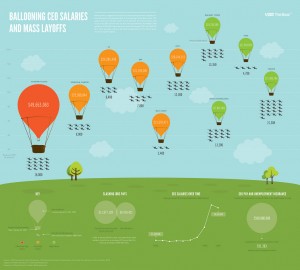|
|
|
Wednesday, September 26th, 2012
 Finally! Finally!
The news that we’ve all been waiting for—unless you’re a CEO who is paid relative to your counterparts.
According to new research by Charles M. Elson, director of the John L. Weinberg Center for Corporate Governance at the University of Delaware, and Craig K. Ferrere, one of its Edgar S. Woolard fellows, the whole idea that a CEO will quit if he isn’t paid more than his peers is, to use a technical term, hogwash.
…contrary to the prevailing line, that chief executives can’t readily transfer their skills from one company to another. In other words, the argument that C.E.O.’s will leave if they aren’t compensated well, perhaps even lavishly, is bogus. (…) “It’s a false paradox,” Mr. Elson said in an interview last week. “The peer group is based on the theory of transferability of talent. But we found that C.E.O. skills are very firm-specific. C.E.O.’s don’t move very often, but when they do, they’re flops.”
Surprise, surprise.
For ‘firm-specific’ read culture and colleagues—the same two things that impact any worker’s success.
Flickr image credit: GDS Infographics (click the graphic to see a large version)
Posted in Business info, Compensation, Culture | No Comments »
Friday, February 3rd, 2012
A Friday series exploring Startups and the people who make them go. Read all If the Shoe Fits posts here
 Last year I wrote about Tony Hsieh’s approach to employee empowerment, featuring some great quotes from him. Last year I wrote about Tony Hsieh’s approach to employee empowerment, featuring some great quotes from him.
As I said then, the thing that sets Hsieh apart is security.
Hsieh is comfortable in his own skin; secure in his own competency and limitations, so he doesn’t need to be the font from which all else flows.
Entrepreneurs can learn from this.
Startup hiring usually comes in waves as the company progresses.
While most founders will listen to their initial team and first few hires, those hired later often find it difficult to get their ideas heard.
Unfortunately, this behavior often sets a pattern, with the ideas and comments of each successive wave becoming fainter and fainter and those employees less and less engaged—and that translates to them caring less and less about your company’s success—call it wave deafness.
Wave deafness is costly.
Costly in productivity and passion, but even more costly in lost opportunities.
As Hsieh points out, there is no way he can think of as many good ideas as are produced if each employee has just one good idea in a year.
And not just from certain positions. I never heard of a manager, let alone a founder, admit to hiring dummies for any position, no matter the level.
So if you hire smart people and don’t listen to them, who is the dummy?
Option Sanity™ rewards creativity.
Come visit Option Sanity for an easy-to-understand, simple-to-implement stock process. It’s so easy a CEO can do it.
Warning.
Do not attempt to use Option Sanity™ without a strong commitment to business planning, financial controls, honesty, ethics, and “doing the right thing.”
Use only as directed.
Users of Option Sanity may experience sudden increases in team cohesion and worker satisfaction. In cases where team productivity, retention and company success is greater than typical, expect media interest and invitations as keynote speaker.
Flickr image credit: HikingArtist
Posted in If the Shoe Fits | 1 Comment »
Friday, July 2nd, 2010
 After Monday’s post I had several emails and calls wondering if the ROI for seeing the ‘whole’ was really worth the effort considering the frequency of switching jobs and even industries, not to mention the speed at which everything changed. One caller said he was exhausted just thinking about it. (He was being factious—I hope.) After Monday’s post I had several emails and calls wondering if the ROI for seeing the ‘whole’ was really worth the effort considering the frequency of switching jobs and even industries, not to mention the speed at which everything changed. One caller said he was exhausted just thinking about it. (He was being factious—I hope.)
So on this Friday, before you grab the beer to celebrate your freedom, let’s consider the ‘whole’ in terms of WIIFY (what’s in it for you).
The short answer is that wrapping your mind around the whole is the difference between being considered ‘good’, ‘OK’ and ‘competent’ vs. having adjectives such as ‘great’, ‘brilliant’ and ‘world-class’ attached to your name.
And making the effort to be a ‘whole’ person provides a major benefit for you, personally by reducing—even eliminating—boredom.
Even a constantly challenging job can become routine; the two things that keep it interesting are people, who are ever-changing, and the intricacies of understanding your and the job’s impact on surrounding people and tasks and how it fits into and impacts the whole.
It’s similar to enjoying a baseball game; if you think the most fascinating position is pitcher and that’s the only player you watch, you’ll miss a lot of the action. In fact, you’ll probably miss many of the game-changing plays.
You’ll actually find a lyric harmony in the ‘whole’ and will be much quicker to notice any discordant notes giving you a decided edge within your current company as well as a more accurate assessment of what is really going on.
Mixing metaphors is not good writing, but this kind of holistic, or perhaps I should say ‘wholistic’ approach will be far more accurate in predicting whether you should fish or cut bait.
How’s that for good WIIFY?
Flickr image credit: http://www.flickr.com/photos/irenetong/485727716/
Posted in Business info, Personal Growth | No Comments »
Monday, June 28th, 2010
 When you evaluate a task or project to you see the whole or the hole? When you evaluate a task or project to you see the whole or the hole?
Most people are adept at seeing the hole, i.e., what needs to be added in order to succeed. What’s missing can include scope, skills, resources, etc.
Unlike donuts, holes don’t enhance your projects. Being sure the hole is filled is important, but it’s also difficult to fill it if you don’t also see the whole.
The whole is the overview of how that particular project fits into the larger picture. Understanding that helps you to identify and address the entire hole, so you don’t end up having to go back and fix the part of the hole you missed or, worse, move on leaving an unnoticeable hole that turns into a sinkhole down the road.
Seeing the whole means taking time to understand not just your own position/area, but the functions of those around you and how they all interact, your company’s competitors and trends in your market.
More work? Yes.
A pain in the wazoo? Yes.
The benefits to you, your team and your company? Priceless.
Stock.xchang image credit: http://www.sxc.hu/photo/758343
Posted in Business info, Personal Growth | No Comments »
Friday, April 23rd, 2010
Today’s post is very short because it requires you to read two others.
First is Dan McCarthy’s wondering if common sense is a learnable skill and offering his own eight steps that might (or might not) help. The first step is a doozy.
Admit you have a problem.
As Dan points out it is probably the hardest step of all.
Reading that post reminded me of a post I did based on an article I read ten years ago about research on incompetence.
“Most incompetent people do not know that they are incompetent. … One reason that the ignorant also tend to be the blissfully self-assured, the researchers believe, is that the skills required for competence often are the same skills necessary to recognize competence.”
Admitting you may be incompetent is far worse than admitting a lack of common sense and so even less likely to happen.
 Which is why you need feedback from a variety of sources; the larger the variety the more accurate the picture. Which is why you need feedback from a variety of sources; the larger the variety the more accurate the picture.
Of course, then you need to listen to it.
Image credit: Karl Horton on flickr
Posted in Communication, Personal Growth | No Comments »
Friday, May 22nd, 2009
Oh goody. Another CEO study. I haven’t seen the study, but David Brooks (NY Times) gives an overview (whatever you do, don’t miss the comments), while Dan McCarthy (Great Leadership laments the fascination with such studies.
 I pretty much ignore them, except for their amusement value—sort of like all the food studies that tell us which food that was recommended last year will kill us this year. I pretty much ignore them, except for their amusement value—sort of like all the food studies that tell us which food that was recommended last year will kill us this year.
Speaking of which, I wish someone would do a study like that on CEOs.
A ranking of CEOs who were lauded for x amount of time before they crashed and burned for the same traits that were their supposed strengths.
And a corollary ranking of all the pundits, gurus and executive coaches who did the lauding and how many have come forward to apologize for mistaking hubris for competence.
Of course, that would be a very long list.
Your comments—priceless
Don’t miss a post, subscribe via RSS or EMAIL
Image credit: Beeeeezzz on flickr
Posted in About Leadership, What Leaders DON'T | No Comments »
|
 Subscribe to
Subscribe to
MAPping Company Success
About Miki 
Clarify your exec summary, website, etc.
Have a quick question or just want to chat? Feel free to write or call me at 360.335.8054
The 12 Ingredients of a Fillable Req
CheatSheet for InterviewERS
CheatSheet for InterviewEEs™
Give your mind a rest. Here are 4 quick ways to get rid of kinks, break a logjam or juice your creativity!
Creative mousing
Bubblewrap!
Animal innovation
Brain teaser
The latest disaster is here at home; donate to the East Coast recovery efforts now!
Text REDCROSS to 90999 to make a $10 donation or call 00.733.2767. $10 really really does make a difference and you'll never miss it.
And always donate what you can whenever you can
The following accept cash and in-kind donations: Doctors Without Borders, UNICEF, Red Cross, World Food Program, Save the Children
*/
?>About Miki
About KG
Clarify your exec summary, website, marketing collateral, etc.
Have a question or just want to chat @ no cost? Feel free to write
Download useful assistance now.
Entrepreneurs face difficulties that are hard for most people to imagine, let alone understand. You can find anonymous help and connections that do understand at 7 cups of tea.
Crises never end.
$10 really does make a difference and you’ll never miss it,
while $10 a month has exponential power.
Always donate what you can whenever you can.
The following accept cash and in-kind donations:
|





 Last year I wrote about
Last year I wrote about  After
After  When you evaluate a task or project to you see the whole or the hole?
When you evaluate a task or project to you see the whole or the hole? Which is why you need feedback from a variety of sources; the larger the variety the more accurate the picture.
Which is why you need feedback from a variety of sources; the larger the variety the more accurate the picture. I pretty much ignore them, except for their amusement value—sort of like all the food studies that tell us which food that was recommended last year will kill us this year.
I pretty much ignore them, except for their amusement value—sort of like all the food studies that tell us which food that was recommended last year will kill us this year.
